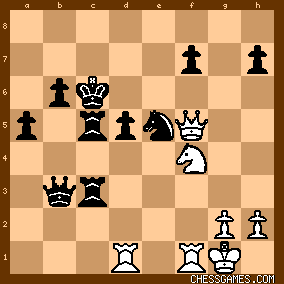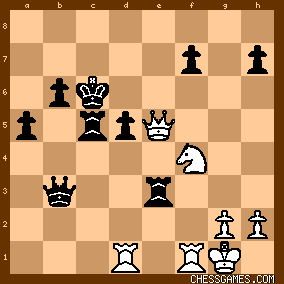| Nov-15-19 | | Carrots and Pizza: I got the first few moves. I would have played ...Nxf5. I didn't anticipate 33...Nc6, but when I saw it, I knew the right move was 34.Nxe6. (Someone please give me some credit for this one.) |
|
| Nov-15-19 | | Lambda: I think this is one of those puzzles where you don't actually need to see much, because as soon as you've figured out black needs to be playing something like 33... Nc6, you've seen enough to justify 33. Nxf5, and in a game, you'd want to look at the position one move on to decide what to do then. |
|
| Nov-15-19 | | mel gibson: I feel bad that I didn't see this one.
Stockfish 10 says:
33. Nxf5
(33. Nxf5 (♘g3xf5 e6xf5 ♕g5xf5+ ♔d7-d6 ♕f5-f6+
♔d6-c7 ♕f6xe5+ ♔c7-b7 ♘f4xd5 ♖c5xd5 ♖d1xd5 ♖c3-c7 ♖d5-d6 ♕b3-c4 ♖f1-b1
♔b7-a7 ♖d6xb6 ♕c4-c1+ ♖b1xc1 ♖c7xc1+ ♔g1-f2 ♖c1-c2+ ♔f2-g3 ♔a7xb6 ♕e5-b8+
♔b6-a6 ♕b8-d6+ ♔a6-a7 ♕d6-d4+ ♔a7-b7 ♕d4-e4+ ♖c2-c6 ♕e4xh7 ♖c6-g6+ ♔g3-h3
♖g6-f6 ♕h7-e4+ ♖f6-c6 ♔h3-g3 ♔b7-c7 ♕e4-f4+ ♔c7-b7 ♕f4xf7+ ♔b7-a6 ♕f7-b3
♖c6-b6 ♕b3-d3+ ♔a6-b7 ♕d3-f3+ ♔b7-a7 ♕f3-a3 ♖b6-b5 h2-h4 ♔a7-b7 h4-h5 a5-a4
♕a3-e7+ ♔b7-a6 ♕e7-f7 a4-a3 h5-h6) +8.36/40 173) score for White +8.36 depth 40. |
|
| Nov-15-19 | | Jambow: <Carrots and Pizza> Credit given... What <Lambda> said. |
|
| Nov-15-19 | | malt: Seen 33.N:f5 Nc6
(33...ef5 34.Q:f5+ Kc6 35.Q:e5 )
34.N:e6! h6
(34...fe6 35.Qg7+ Kd8 36.Nd4 )
(34...K:e6 35.Rde1+ Kd7 36.Rd7+ )
(34...Rb5 35.Qg7 Kc8 36.Qf8+ )
35.N:c5+ R:c5 36.Q:h6 |
|
| Nov-15-19 | | TheaN: Interesting yet also disappointing Friday. Black has a whooping collection of pawns for the knight on g3, and the most dangerous ones are a and b. In order to create any counter play against the a-pawn rolling, White will have to blow the center wide open. If White can't play <33.Nxf5> I reckon he's just lost. But he can. After a knight retreat like Nc6 (which was actually played) White already took one pawn and activated all pieces, usually a bad deal for the side a piece down. After <33....exf5 34.Qxf5+ Kd6 35.Qf6+> it's obvious Black lost two pawns for nothing, and the center is indeed wide open. After <35....Kd7> Kc7 is better but less logical <36.Qxe5>. 
click for larger viewThis is exactly the position I was not entirely sure about and evaluated as "looks good" and decided it's the best for White. It's absolutely devastating: Black cannot stop a piece avalanche, primarily on f7. The pawns are no longer an asset, two are gone, and Black has no play left. What looked daunting is gone in three moves. |
|
| Nov-15-19 | | TheaN: Interestingly, I play the French myself and I immediately recognized this as a position coming from a Steinitz French. Hadn't foreseen it was actually a sac on b4 but in hindsight that's pretty much the only thing it could be. Study worthy game to go through. |
|
| Nov-15-19 | | TheaN: Black's game took a turn for the worst with 24....Qb3?! which is a logical idea but the wrong execution: 24....Qa6!= would have prevented White's follow up and a balanced game. White surrenders the advantage with 27.Nd3?! Rac8=, 27.Qd2 ⩲, but then Black claims a bit too much with 28....a5?! 29.f5! ±. After 30.Nf4, the only practical draw Black has is 30....Rxg3!? which looks ridiculous but the position a rook down is worse than allowing Qh5. After 31.hxg3 Rc2 32.Qe1, apparently Black can trade queens (rook down!?) with 32....Qc3 33.Qxc3 Rxc3. e5 and g3 are en prise, and White has to counter tactically with 34.Rxd5! Rxg3 35.Rb5 ± but this is not an easy win. After 31.Qh5 +- it's done. Black could have still tried Rxg3 but with the queen out of the position, White's winning. 32....Kd7 1-0 was the nail in the coffin, but 32....Ke8 +- was not that much better. |
|
Nov-15-19
 | | chrisowen: Les Miserable; |
|
| Nov-15-19 | | drollere: the meaty point is that after 34. .. f:e6 or 36. N:e7 black is mated in a few moves, for example: 34...Kxe6, 35. Rde1+ Kd7, 36. Re7+ Nxe7, 37. Qxe7+ Kc8, 38. Nd6+ Kb8, 39. Qb7# |
|
| Nov-15-19 | | patzer2: Positions with an extra minor piece versus three pawns are often very difficult. Depending on one's tactical skill level, that may or may not be the case with today's Friday puzzle position (33. ?). I found it extremely difficult, even though I managed to correctly guess White's first two moves 33. Nxf5!! Nc5 34. Nxe6! +- (+20.43 @ 27 ply, Stockfish 10). However, after 34...Kxe6 I missed the strong winning follow-up 35. Rde1+ Kd7 36. Re7! +- (M7 Stockfish 10 @ 52 ply). Instead, after 34...Kxe6, I went with 35. Nd7+ Kd7 (35...Kd6 36. Ne8+ +- M15) 36. Rxf7+ +- (+9.121 @ 41 ply, Stockfish 10) which still wins but with more difficulty than the game continuation. P.S.: So where can Black improve? I like <TheaN>'s idea of attempting to force a Queen trade with 24...Qa6 25. Qxa6 Nxa6 ⩲ to =, but after 24...Qa6 25. Qb4 ± (+1.11 @ 41 ply, Stockfish 10) White still has the advantage. Instead of avoiding <24...Qb3>, it seems Black can safely play it and achieve equality after 24...Qb3 25. Qe2 a5! = (0.00 @ 35 ply, Stockfish 10). Earlier in the opening, instead of entering this complicated line with 7...Qb6, I prefer the popular move 7...a6 as in Black's recent win in Ivanchuk vs Akobian, 2019. |
|
| Nov-15-19 | | TheaN: <patzer: P.S.: So where can Black improve? I like <TheaN>'s idea of attempting to force a Queen trade with 24...Qa6 25. Qxa6 Nxa6 ⩲ to =, but after 24...Qa6 25. Qb4 ± (+1.11 @ 41 ply, Stockfish 10) White still has the advantage.> Fair enough, that was the limited ply of CG's SF9. 24....Qb3 25.Qe2 a5 is indeed the way to play. 25....Nd7 is almost +-. <Earlier in the opening, instead of entering this complicated line with 7...Qb6, I prefer the popular move 7...a6 as in Black's recent win in Ivanchuk vs Akobian, 2019.> This may as well be a degree of style. In a recent game I received the Nf4-line of the Ne2 Tarrasch: 1.e4 e6 2.d4 d5 3.Nd2 Nf6 4.e5 Nfd7 5.Bd3 c5 6.c3 Nc6 7.Ne2 cxd4 8.cxd4 f6 9.Nf4!? Nxd4!? 10.Qh5+ with very complicated play. Lost my track somewhere but should probably have won. The 'timid' response in that setup is 9....Qe7 (Black is still saccing the exchange, but in line of 10.Qh5+?! Qf7 11.Bg6? hxg6 12.Qxh8 Nxd4 -+ Black will also grab e5 and and cruise control to a win, exchange down). After 10.Nf3 ⩲ Black's supposed to be fine, but not more than that, and it's still tough to play. The analogy does not hold fully though, as the line I played is the main line. Qb6 in this game is definitely a deviation. Still Black was fine after Nxb4 and plays it in the true center and queen side style. Just lost his track later. |
|
| Nov-15-19 | | agb2002: White has a knight for five pawns.
White can take advantage of the position of the black king 33.Nxf5: A) 33... exf5 34.Qxf5+
A.1) 34... Kd6 35.Qf6+
A.1.a) 35... Kd7 36.Qxe5 Kc6 (trying to protect d5) 37.Nxd5 wins decisive material (37... Rxd5 38.Rxd5 Qxd5 39.Qxc3+). A.1.b) 35... Kc7 36.Qxe5+ as above.
A.2) 34... Kc6 35.Qxe5, with the threats Nxd5, Qe8+ and Qf6+, looks very good for White. B) 33... Nc6 34.Nxe6
B.1) 34... fxe6 35.Qg7+
B.1.a) 35... Kd8 36.Nd4 with the double threat Rf8# and Nxb3. B.1.b) 35... Kc(e)8 36.Nd6+ and mate next.
B.1.c) 35... Ne7 36.Qxe7+ Kc6 (36... Kc8 37.Nd6+ Kb8 38.Qb7#) 37.Nd4#. B.2) 34... Kxe6 35.Rde1+ Kd7 (35... Ne5 36.Nd4+ Kd6 37.Nxb3) 36.Re7+ Kc8 (36... Nxe7 37.Qxe7+ as in B.1.c; 36... Kd8 37.Qg8#) 37.Qg8+ Nd8 38.Nd6+ Kb8 39.Qxd8+ Rc8 40.Nxc8 Rxc8 41.Qd7 wins. B.3) 34... R5c4 35.Rxd5+ looks winning.
C) 33... Ng6 34.Nd4 (34.Nxg6 exf5 -34... f(h)xg6 35.Qe7+ as in B.1.c- 35.Qxf5+ looks also very good for White) followed by Nxg6 and Rf7+ seems to win. |
|
Nov-15-19
 | | Jimfromprovidence: Here is the position after 33 Nxf5 exf5 34 Qxf5+ Kc6.
click for larger viewI was thinking after 35 Qxe5 Re3, that black might be ok, with an escape square for the king at b5. 
click for larger viewI had not realized that after 36 Qf6+ 36...Kb5 is not playable because of 37 Rb1. 
click for larger view |
|
| Nov-15-19 | | JohnBoy: I like the exchange here between <TheaN> and <patzer2>. In OTB days I rarely played the French, and absolutely did not understand how the black side worked (i.e. never sufficiently studied Botvinnik) and paid for it. Thanks! |
|
| Nov-15-19 | | TheaN: <JohnBoy: I like the exchange here between <TheaN> and <patzer2>. In OTB days I rarely played the French, and absolutely did not understand how the black side worked (i.e. never sufficiently studied Botvinnik) and paid for it. Thanks!> Typically, the French may easily be Black's most aggressive response to e4, but it's not to everyone's taste due to the closed nature of Black's own queen side. Many would argue that the Sicilian is more 'aggressive' but that's not really true: the only real accomplishment of the Sicilian is an unbalance (I play it as well, so it's not trashing here). It gives both colors weaknesses, but White still has the move advantage. It's popular just because the game is so on edge but White should still keep some control. The French is the opposite so may psychologically be harder for White: Black's clear on move one: "that center's going to be challenged head on, good luck". If the center stays intact White is usually better, but it's a still a tough nut to crack as the king side is not indefinitely surrendered by Black. If the center remains pressured, complicated lines tend to go all over the place. If the center's dismantled, Black usually annihilates. Exceptions exist, but the above is why the French can be so appealing: it's somewhat cramped nature masks the fact White has some serious concessions to make early on. |
|
|
|
|





































